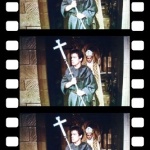Becket Cross

By Paul Harding, with
thanks to Sean Wright
for his inspiration.
Becket Starred Richard Burton, Peter O'Toole, John Gielgud, Donald Wolfit, Martita Hunt, Pamela Brown & Siân Phillips.
The plot relates the conflict between Archbishop of Canterbury Thomas Becket and England's King Henry II. As is the custom, a monk* carries the Archiepiscopal Cross facing backwards, so that the Archbishop following the cross can keep his eyes on the corpus.
In Act III of the play Becket says "Now give me my silver cross. I must hold it." as he prepares himself for martyrdom. Archiepiscopal crosses are often made of silver to reflect their special importance, and Becket decided it was time to hold this ceremonial cross for himself, just as Jesus had carried the cross to Golgotha.
The interesting feature of this cross is that the titulus (the short upper crossbar) is at the very top of the cross like a Tau Cross.
In the West, the titulus of an Archiepiscopal Cross is usually shown lower down. The titulus at the very top of the cross is popular throughout Ukraine and Russia.
There seems to be no reason why the titulus can't be at the very top of an Archiepiscopal cross, as with this 'Becket Cross'. Indeed, such a design could be used as a crutch for an aging prelate to place under his armpit for support whilst standing. But tradition seems to dictate that the titulus is lower down.
If you've seen an Archiepiscopal cross similar to this design, please send us details and we'll update the page. We've called it the 'Becket' for want of a better name, so if you know a more established name we'd be delighted to know (enquiry@seiyaku.com).
😄 And finally, a little story about a monk
Asian languages have a similar symbol, albeit the upper bar is much longer. In Chinese and Japanese it represents "dry", amongst other things, and originates from a pictograph of food (fish, meat, etc.) atop a pole, drying in the wind. In old Korean, the symbol represented the monarch of the kingdom of Silla.


